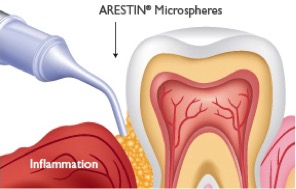When plaque (bacteria) is not controlled by Home Care and Routine Preventive Cleanings, it begins to harden on the tooth, creating a shell of Tartar or Calculus. As this layer expands, the gingival (gum) tissue becomes swollen and tender. The infected area of the gums begins to separate from the tooth causing a deep pocket between the gum and tooth structure. The Periodontal Pocket becomes deeper with time, and when left untreated, creates the risk of losing an adult tooth.
The loss of a tooth due to gum disease can be prevented. Along with Scaling & Root Planing (SRP), Arestin fights the bacteria that causes gum disease. Periodontal Disease is an infection caused by bacteria, and like other infections, it can be treated with an antibiotic. Unlike antibiotics that are swallowed, Arestin is a powder that your Dentist or Hygienist places directly into the infected pockets around your tooth after completing Scaling & Root Planing. Arestin powder contains tiny microspheres of the antibiotic minocycline, which is released over time into the infected pocket. This means Arestin keeps fighting plaque (bacteria) after the patient has left the dentist’s office. Arestin kills the bacteria most commonly associated with Periodontal Disease and has been shown to significantly reduce the depth of Periodontal Pockets.
Arestin contains minocycline, a tetracycline derivative and should not be used in patients with tetracycline allergies, children, and women who are pregnant or nursing.
Procedure

Arestin works together with Scaling & Root Planing to be nearly 3 times more successful than treatment with Scaling and Root Planing alone in severe periodontal disease. By Scaling & Root Planing, the Hygienist removes the hard bacterial Tartar that irritates the gums and causes infection. Adding Arestin helps kill the bacteria that Scaling & Root Planing cannot reach and prevents new plaque from entering the healing pocket. Arestin microspheres are painlessly added to the infected pocket using a special plastic applicator. The Antibiotics are released over time, helping to keep bacteria from returning while the gum heals. After three months, the patient returns for a Periodontal Maintenance appointment. The pocket depths are monitored for improvement. If a pocket has improved but is still deeper than 5 mm and/or bleeding on probing, another dose of Arestin may be placed.
Post-Placement Instructions for Arestin
- Wait at least 10 days before using floss, toothpicks or other devices designed to clean between teeth or below the gum line.
- Do not touch treated area for one week.
- Avoid eating hard, crunchy, or sticky foods for one week.
- After 10 days, begin to brush and floss as instructed by your Dentist or Hygienist.
- Increase Oral Home Care, and develop a daily routine.
- Follow up with your Dentist or Hygienist in 3 months for your Periodontal Maintenance appointment. At this time, the areas where Arestin was placed will be checked to monitor the gum’s improvement. If the pocket has improved but is still deeper than 5 mm and/or bleeding on probing, another dose of Arestin may be necessary.
Insurance Coverage
Most Dental Insurance Companies do not cover or have only partial coverage for Arestin medication. Recently, however, Arestin has teamed up with CVS to help patients with this problem. For patients with treatments requiring Arestin in multiple sites, an Arestin Request Form can be faxed to CVS. The patient can apply to receive the medication using their Prescription Drug Plan. Once approved by their insurance, CVS will contact the patient to collect their co-payment and then ship the Arestin directly to our office. This medication is labeled and stored for that patient’s personal use. This manner of payment is recommended for large cases of Quadrant Scaling where the need for Arestin can be planned in advance. Co-payment may vary depending on the patient’s policy, but with large cases, it is much less expensive than individual units out of pocket.

